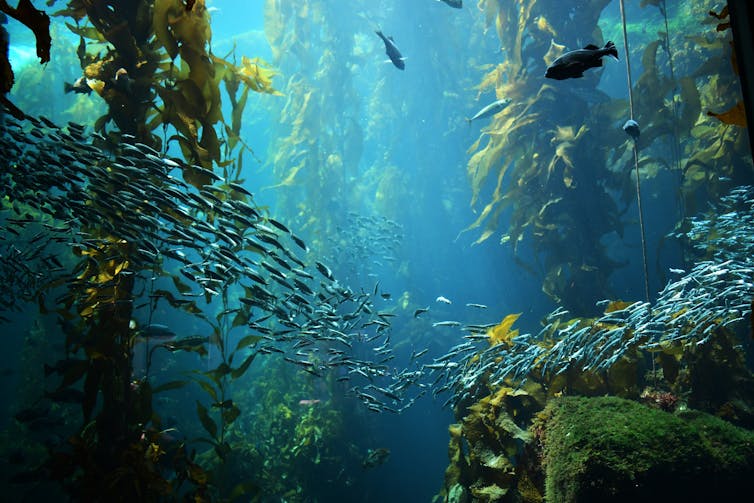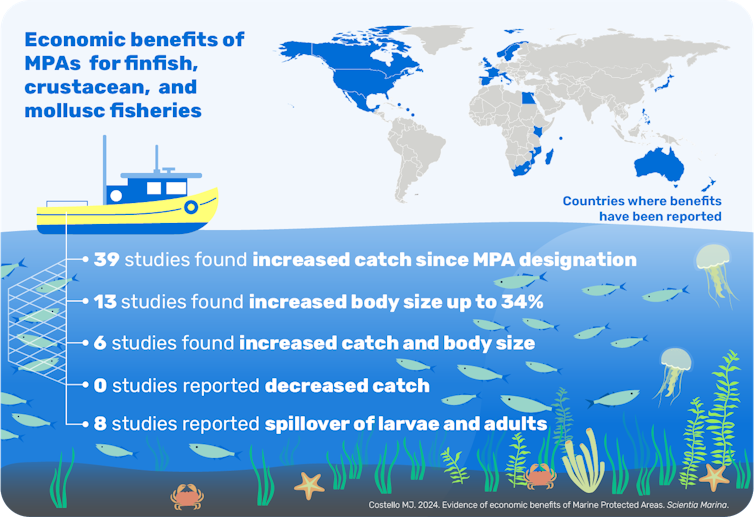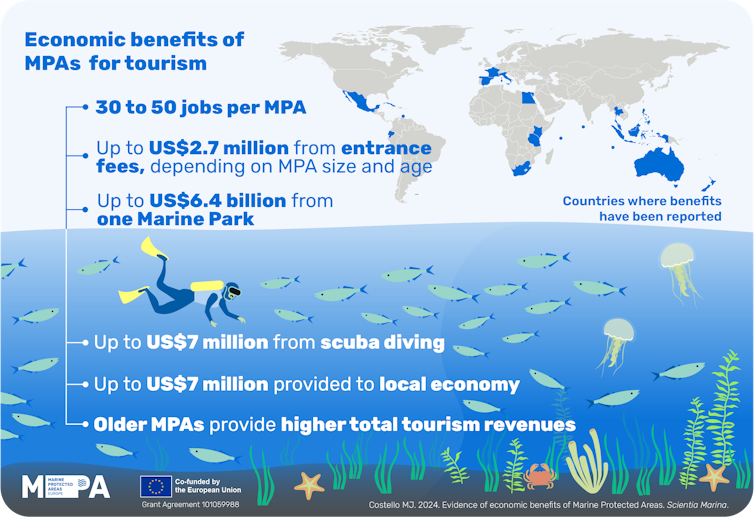Marine protected areas safeguard more than ecology – they bring economic benefits to fisheries and tourism
Marine Protected Areas (MPAs) have been used as a conservation measure for decades, but critics continue to argue that evidence of their economic benefits is weak, particularly with regard to fisheries.
Given the challenges in establishing MPAs, including objections from fisheries and the frequently small size and sub-optimal location of protected areas, one would expect their economic benefits to be hard to detect.
My new study reviews 81 publications about MPAs in 37 countries. It shows their establishment has resulted in benefits to commercial fisheries in 25 countries and to tourism in 24. These benefits covered a diversity of ecosystems, including coral reefs, kelp forests, mangroves, rocky reefs, salt marshes, mudflats and sandy seabed habitats.
My new study reviews 81 publications about MPAs in 37 countries. It shows their establishment has resulted in benefits to commercial fisheries in 25 countries and to tourism in 24. These benefits covered a diversity of ecosystems, including coral reefs, kelp forests, mangroves, rocky reefs, salt marshes, mudflats and sandy seabed habitats.

Kelp forests are among the marine ecosystems that benefit from protection. Shutterstock/Andrew b Stowe
There were 46 examples of economic benefits to fisheries adjacent to a marine protected area. These include increased fish stocks and catch volumes, higher reproduction and larval “spillover” to fisheries outside the MPA. Other studies also reported larger fish and lobsters close to existing MPAs.
Despite claims in the research literature of fishery displacement due to the establishment of an MPA, it seems the benefits outweigh any temporary disruption of fishing activities.
In my research, I have found no evidence of net costs of an MPA to fisheries anywhere, at any time.
Fishery models need to account for protection benefits
Most economic models estimating the costs marine protected areas impose on fisheries don’t account for the present costs of fishery management (or absence of management).
When an entire fishery is closed temporarily by fishery management, the models estimate the potential benefit from stock recovery. But they don’t do that when a fraction of a fishery is closed for the long-term in an MPA.
Overall, my research shows that MPAs which ban all fishing have lower management costs and greater ecological and fishery benefits than more complex fishery regulations within a protected area. Thus, the economic models of the effects of MPAs need radical revision.
Although it may seem counterintuitive that a full restriction of fishing in an area will result in more fish elsewhere, this happens because MPAs act like a reservoir to replenish adjacent fisheries.
There were 46 examples of economic benefits to fisheries adjacent to a marine protected area. These include increased fish stocks and catch volumes, higher reproduction and larval “spillover” to fisheries outside the MPA. Other studies also reported larger fish and lobsters close to existing MPAs.
Despite claims in the research literature of fishery displacement due to the establishment of an MPA, it seems the benefits outweigh any temporary disruption of fishing activities.
In my research, I have found no evidence of net costs of an MPA to fisheries anywhere, at any time.
Fishery models need to account for protection benefits
Most economic models estimating the costs marine protected areas impose on fisheries don’t account for the present costs of fishery management (or absence of management).
When an entire fishery is closed temporarily by fishery management, the models estimate the potential benefit from stock recovery. But they don’t do that when a fraction of a fishery is closed for the long-term in an MPA.
Overall, my research shows that MPAs which ban all fishing have lower management costs and greater ecological and fishery benefits than more complex fishery regulations within a protected area. Thus, the economic models of the effects of MPAs need radical revision.
Although it may seem counterintuitive that a full restriction of fishing in an area will result in more fish elsewhere, this happens because MPAs act like a reservoir to replenish adjacent fisheries.
Author provided, CC BY-SA - Click to view
In financial terms, the capital is invested and people benefit from the interest on the investment. To count the establishment of an MPA as a cost to fisheries is like claiming that interest earned on money is a cost.
In some areas, fishery controls such as quota and the type of gear allowed already restrict fishing over larger areas than a MPA (especially when most MPAs still allow some fishing).
An analysis of the long-term effects of marine reserves in Sweden found they complemented fishery management measures. But when they were reopened to fisheries, even if temporarily, the benefits were promptly lost.
MPAs represent a simple, viable, low-tech and cost-effective strategy that can be used for small and large areas. As such, they have proven highly successful both for safeguarding marine biodiversity and ecosystem functioning. More pertinently, they reverse fishery declines, secure food and ecosystem services and enable the sustainable exploitation of marine resources.
MPAs shift the management of fisheries from being purely a commercial commodity to include the wider socio-economic benefits they provide to coastal communities. This includes food security, cultural activities and sustainable likelihoods. A recent review of 118 studies found that no-take, well enforced and older MPAs most benefited human wellbeing.
In financial terms, the capital is invested and people benefit from the interest on the investment. To count the establishment of an MPA as a cost to fisheries is like claiming that interest earned on money is a cost.
In some areas, fishery controls such as quota and the type of gear allowed already restrict fishing over larger areas than a MPA (especially when most MPAs still allow some fishing).
An analysis of the long-term effects of marine reserves in Sweden found they complemented fishery management measures. But when they were reopened to fisheries, even if temporarily, the benefits were promptly lost.
MPAs represent a simple, viable, low-tech and cost-effective strategy that can be used for small and large areas. As such, they have proven highly successful both for safeguarding marine biodiversity and ecosystem functioning. More pertinently, they reverse fishery declines, secure food and ecosystem services and enable the sustainable exploitation of marine resources.
MPAs shift the management of fisheries from being purely a commercial commodity to include the wider socio-economic benefits they provide to coastal communities. This includes food security, cultural activities and sustainable likelihoods. A recent review of 118 studies found that no-take, well enforced and older MPAs most benefited human wellbeing.

Tourism also benefits from marine protected areas. Getty Images/Ullstein Bild
MPAs can generate billions from ecotourism
In addition to economic benefits to fisheries, MPAs that are accessible to the public, and which harbour biologically diverse habitats, can generate millions to billions of dollars in tourism revenue per year.
This revenue is generated not only from entrance fees and MPA-associated businesses that may develop, but also from providing jobs and therefore improving the local economy and living standards, while contributing significantly to national GDP.
The largest benefits to fisheries and biodiversity, and lowest costs in management, come from the designation of MPAs from which no marine wildlife can be killed or removed.
This principle has been termed Ballantine’s Law after the late New Zealand marine biologist Bill Ballantine, known as the “father of marine reserves”.
Author provided, CC BY-SA - Click to view
Back in the 1970s, Ballantine championed what was then a radical idea – that MPAs should be entirely no-take, permanent areas called marine reserves. This led to the establishment of New Zealand’s first marine reserve.
I have worked with Ballantine and one of our earlier studies found three-quarters of coastal countries didn’t have even one marine reserve. Today, less than 3% of the global ocean is under some form of protection.
Considering the proven benefits and popularity of MPAs, this is a missed opportunity for these countries’ economies and public engagement with nature. Once people witness the benefits of a fully protected area they are likely to want more.
Back in the 1970s, Ballantine championed what was then a radical idea – that MPAs should be entirely no-take, permanent areas called marine reserves. This led to the establishment of New Zealand’s first marine reserve.
I have worked with Ballantine and one of our earlier studies found three-quarters of coastal countries didn’t have even one marine reserve. Today, less than 3% of the global ocean is under some form of protection.
Considering the proven benefits and popularity of MPAs, this is a missed opportunity for these countries’ economies and public engagement with nature. Once people witness the benefits of a fully protected area they are likely to want more.

New Zealand’s first marine reserve has seen an increase in fish numbers, such as large shoals of blue maomao. Shutterstock/Bill Xu
The fishing industry and fishing communities have much to gain from MPAs. But outdated misconceptions perpetuated in the scientific literature create barriers to their implementation.
A recent global analysis has prioritised where to locate MPAs to meet the pledge to fully protect at least 30% of ocean habitats by 2030. This goal is supported by the Convention on Biological Diversity, UN Convention on the Law of the Sea and the International Union for Conservation of Nature.
Fishery scientists and fishermen need to promote the placement of MPAs as a strategy to support biodiversity, including ecosystem-based management of fisheries. They should work with conservation scientists to realise the true capacity of MPAs for economic success.
Marine protected areas represent our best strategy to reverse declining biodiversity and fisheries, because business-as-usual for global fisheries is unsustainable.
Professor Mark John Costello, Faculty of Biosciences and Aquaculture, Nord University. This article is republished from The Conversation under a Creative Commons license. Read the original article
The fishing industry and fishing communities have much to gain from MPAs. But outdated misconceptions perpetuated in the scientific literature create barriers to their implementation.
A recent global analysis has prioritised where to locate MPAs to meet the pledge to fully protect at least 30% of ocean habitats by 2030. This goal is supported by the Convention on Biological Diversity, UN Convention on the Law of the Sea and the International Union for Conservation of Nature.
Fishery scientists and fishermen need to promote the placement of MPAs as a strategy to support biodiversity, including ecosystem-based management of fisheries. They should work with conservation scientists to realise the true capacity of MPAs for economic success.
Marine protected areas represent our best strategy to reverse declining biodiversity and fisheries, because business-as-usual for global fisheries is unsustainable.
Professor Mark John Costello, Faculty of Biosciences and Aquaculture, Nord University. This article is republished from The Conversation under a Creative Commons license. Read the original article




4 comments:
So, you've studied MPA's all over the world and proven their merits, which all seems perfectly logical, and I think the vast majority would support you on that.
You mention 'Ballantine's Law' which seem eminently sensible and appropriate, and it's truly fantastic that it hails from New Zealand - something we should all feel proud of and be thankful for the efforts of the late Bill Ballentine and also people like yourself.
That said, it's all the more lamentable that, as a nation, we don't hold to that 'law' and permit a cohort that purportedly has a 'special relationship with the environment', to be free to run roughshod over it.
What a sad indictment of our country and my, aren't some of us hypocrites?
the fact that there's net benefit to NZ or the world does not negate the net losses to individuals by implementing such bans. if NZ does manage to generate billions from ecotourism, how do you propose to redistribute the benefits to those who would have used the area for fishing? this would simply entrench the concept of a 'welfare state' :(
why not ask all the environmentalists, businesses and academics who are passionate about this to front up the money to pay those who wish to fish in this region?
All the good must be why Iwi were so supportive of the Kermadec marine park.
Oh, sorry, April 1st isn't until tomorrow.
Bollocks! anon@1.21pm. If businesses make money, and all those tourists need other things like transport, food, accommodation etc, then they all pay taxes and make it less expensive for you to pay your share - that is unless of course we have a Labour Government who like nothing more than increasing the tax take, keeping you impoverished and by spending your money. And just be thankful you don't live in most states of Australia. For most living there you can't even drop a line in the sea without paying for a licence.
Post a Comment
Thank you for joining the discussion. Breaking Views welcomes respectful contributions that enrich the debate. Please ensure your comments are not defamatory, derogatory or disruptive. We appreciate your cooperation.